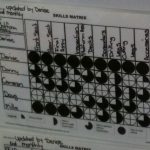
Effectively Using a Skills Matrix to Develop Your Team
The “people issues” become critical as we develop processes and standard ways of working to optimise our efficiencies and workflow. Effectively using a skills matrix is key to developing your people to meet these new challenges. Here we’ll look at what a skills matrix is, why it’s important and how to use a skills matrix to develop our people.
